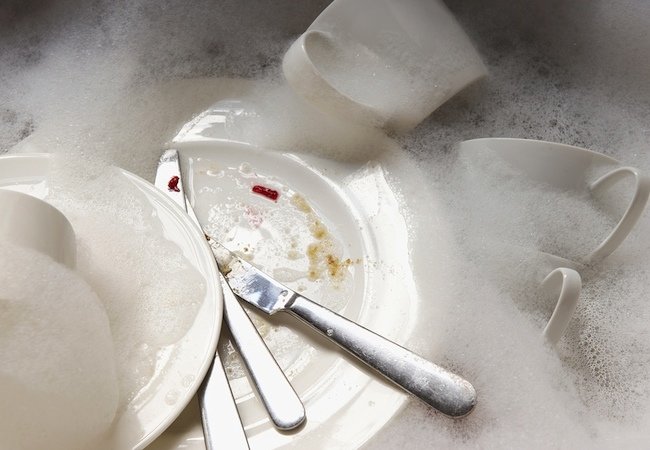We may earn revenue from the products available on this page and participate in affiliate programs. Learn More ›
Homemade dish soap. OK, sure. But why? For one thing, why not? But more seriously, homemade dish soap, which requires little time and effort to make, actually results in something that’s easier on the skin and easier on the wallet—we call that a win-win. So on your next run to the grocery store, add three extra ingredients to your cart, and you’ll be well on your way to concocting a homemade dish shop that really cuts through grease and does most of the dirty dish work for you.
MATERIALS AND TOOLS:
– Unscented, undyed bar soap
– Cheese grater
– Borax
– Essential oil
– Saucepan and spoon
– Washing soda (optional)

STEP 1
Start by using a cheese grater—whatever you have, be it a box grater or a cheese plane—to shave down the bar soap into flecks. While many recipes call for castile soap, any unscented variety does the trick.
STEP 2
Next, combine about 1 tablespoon of grated soap with 1 tablespoon of borax in a bowl. Note that borax, also known as sodium borate, is a powerful antimicrobial cleaning agent (you can find it in the cleaning aisle of your grocery store). Be sure to purchase borax and not boric acid; they’re not the same thing.
STEP 3
Commercial dish soaps contain sodium laurel sulfate, an ingredient that besides producing lots of bubbles, doesn’t do much. (For some people’s skin, sodium laurel sulfate is an irritant.) If you think you’re going to miss the sudsy-ness of the dish soap you’re accustomed to, add 1 tablespoon of washing soda (also known as soda ash or sodium carbonate) to the grated soap-and-borax mixture at this point.
STEP 4
In a saucepan, heat 1 3/4 cups of water until it boils. Stir in the ingredients mixed in previous steps, and continue stirring until the soap has melted and the powders have dissolved. Turn off the heat and leave the mixture to cool for a few hours, stirring the liquid occasionally in order to keep it from solidifying.
STEP 5
Transfer your homemade dish soap into a squirt bottle. In the process, add 15 to 20 drops of essential oil in whatever scent you prefer (e.g., lavender, citrus, or peppermint). The addition of oil makes doing the dishes a sensory experience you might even enjoy. Citrus oils, in particular, can even improve the effectiveness of your homemade dish soap, making it better able to cut through accumulations of grease.
Additional Tips
Use homemade dish soap just as you would commercial dish soap. However, it’s best to shake homemade dish soap before using it, as the ingredients have the tendency to settle and in time, solidify. Even with the addition of washing soda, you are likely to notice that there are fewer suds in homemade dish soap. That’s to be expected, but don’t worry: It’s by no means evidence of an inferior cleaning agent. If anything, it’s a sign that there’s nothing in your soap that shouldn’t be!

